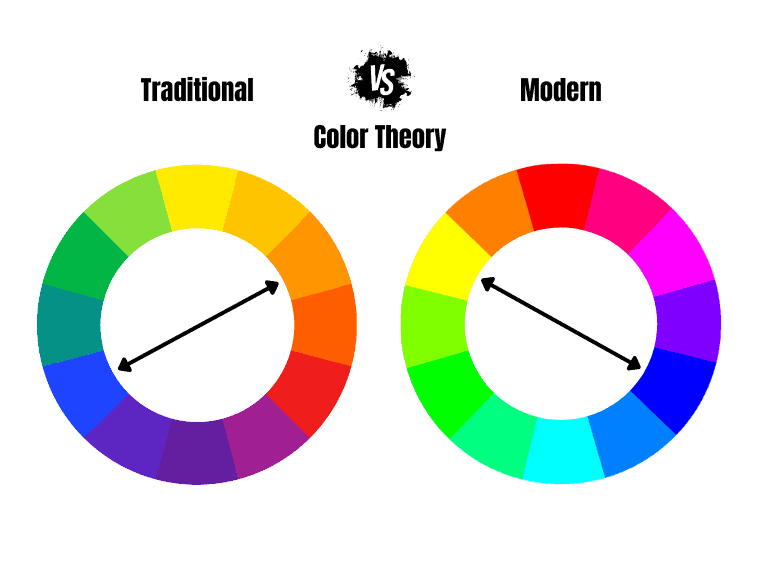We’ve all wondered at least once what is the opposite of blue. In today’s article, you’ll learn all about the opposite color of blue in both pigment and light.
Each color has one opposite on the color wheel. But what happens when you have more than one color wheel? In color theory, we deal with three main color models: RGB, CMYK, and RYB.
If you ask a web designer and an artist what is the opposite of blue color, you will get different answers. The painter will answer orange, while the web designer will say yellow.
That’s because the opposite color of blue differs from one model (or color space) to another. You’ll find out what that means later.
In this post, you will find the answer to several questions, such as:
- What is the opposite of blue on different color wheels?
- What are the opposite colors of different shades of blue?
- Why should you use them in your next design?
What Is the Opposite of Blue?
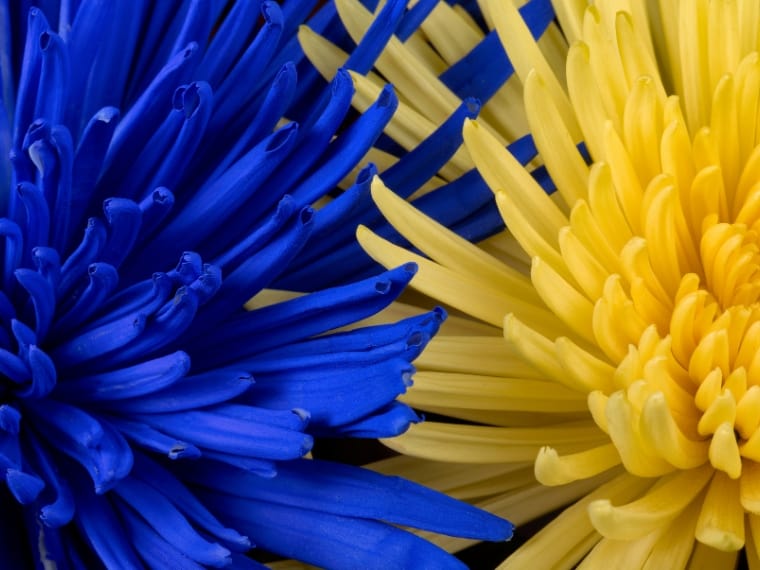
Opposites – or complementary colors – face each other on the color wheel. When paired, they provide the most powerful contrast.
When combined, they neutralize each other, losing their hue. For example, if you mix two opposite colors, you’ll get different neutral gray-brown colors.
But why are opposite colors complementary?
Opposites are considered complementary colors because of the way our eyes perceive color. The science behind this concept lies in our understanding of color vision and the interactions between different wavelengths of light.
They are considered complementary because they stimulate different types of cone cells (or photoreceptors) in our eyes. These receptors contribute to color vision.
In modern color theory, the opposite of blue is yellow, which predominantly stimulates the red and green cones while minimizing the response of the blue cones.
Cones are classified into three types based on their sensitivity to different wavelength ranges: [1]
- Red-sensing cones (60%)
- Green-sensing cones (30%)
- Blue-sensing cones (10%)
Complementary colors stimulate these cones in a way that maximally activates each type of cone cells, creating a balanced response.
That explains why the color opposite of blue makes a good pair with this hue. However, there are several color models. Let’s find out the opposite of blue on each color wheel.
What Is the Opposite of Blue in RGB?
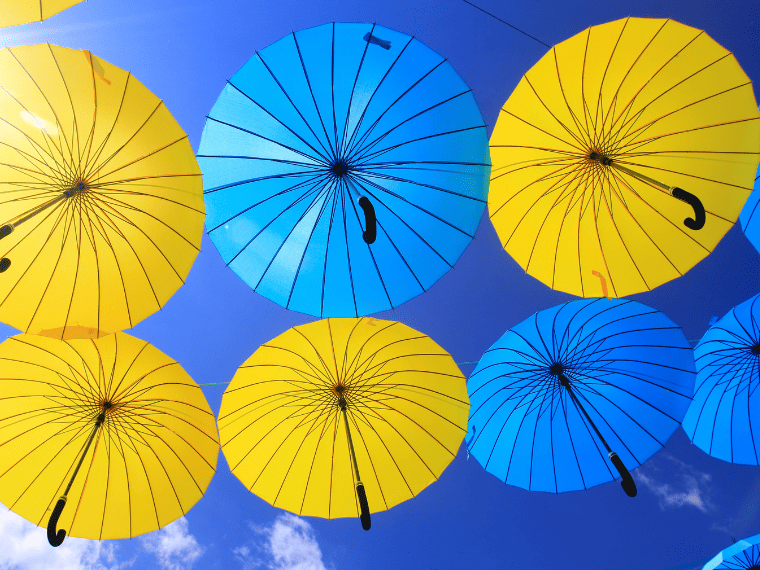
In modern color theory, there are two major color models:
- CMY – subtractive model
- RGB – additive model
CMY is a subtractive color model that deals with pigment and ink. Its primary colors are cyan, magenta, and yellow. In the printing world, you might hear of CMYK, but it’s the same thing, except that black (K) is added to enhance the darkness of colors.
When it comes to light, we’re talking about RGB – an additive color model that uses the primary colors red, green, and blue.
These primary colors are additive colors because the additive pattern starts with black (no light). As color is added, it becomes lighter. Furthermore, you get white light when the primary colors are mixed at maximum intensity.
This color model is used by any digital device that emits colored light, including smartphones, laptop and computer screens, TVs, and so on. But what does it mean?
RGB is used by graphic designers, web designers, developers, and video or movie makers.
The opposite of blue on the color wheel is yellow – the secondary color created by blending the other two primary colors – red and green.
Blue
Hex #0000FF
RGB 0, 0, 255
CMYK 100, 100, 0, 0
Yellow
Hex #FFFF00
RGB 255, 255,0
CMYK 0, 0, 100, 0
In the RGB model, the opposite color of blue is yellow because if you subtract a color from white, you get the complementary color.
When you mix red, green, and blue light at full intensity (resulting in white), and then subtract blue light, you are left with red and green. And when these colors are combined, they create yellow. That’s why yellow is the opposite of blue in the RGB color model.
One of the complementary color meanings also refers to the after-effect or affect-image effect. So, if you look for a few moments at a blue background and then look at a white wall, you will see yellow (for a few seconds) – this is not an illusion but explains how the cone cells in your retina, the photoreceptors that help colour vision, work.
But blue has two neighbors on the color wheel, which are tertiary colors: violet (which leans towards magenta) and azure (which leans towards cyan). These are created by mixing the primary color blue with the secondary colors magenta (violet) and cyan (azure).
Thus, orange is the opposite of azure blue (a lighter blue).
If we go to the green side of blue (greenish-blue), we see that the opposite of cyan – a secondary color in the RGB color wheel – is red.
What Is the Opposite of Blue in CMY?
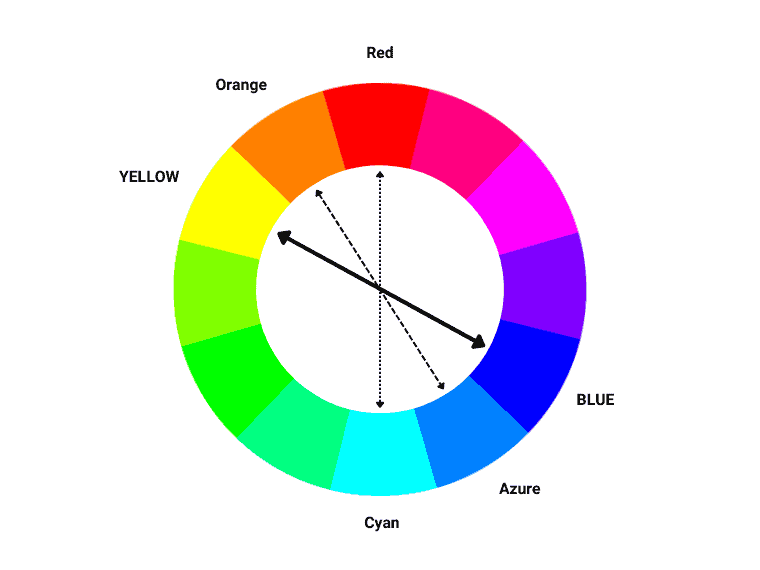
The RGB and CMY color wheels are opposites but go hand-in-hand. They are part of modern color theory.
CMY – a subtractive color model used to mix pigment and ink – works hand-in-hand with the RGB space – an additive color model that deals with light. The secondary colors of the CMY model are the primary colors of the RGB space, and vice versa.
As its name suggests, CMY’s primary colors are cyan, magenta, and yellow.
These are the subtractive primary colors. As mentioned above, mixing them produces secondary colors (or additive colors): red, green, and blue.
Blue is a secondary color on the CMY color wheel, formed by mixing cyan and magenta. The complementary color to blue, or the opposite color on the color wheel, is yellow – the same as in the RGB model.
Blue #0000FF
Yellow #FFFF00
The complementary color to cyan is red – one of the additive primary colors (RGB) or just a secondary color in the CMY model.
But between blue and cyan on the color wheel, there is a tertiary color: azure blue.
The opposite of the tertiary color azure blue – a mixture of blue and cyan – is orange.
What Is the Opposite of Blue in RYB?
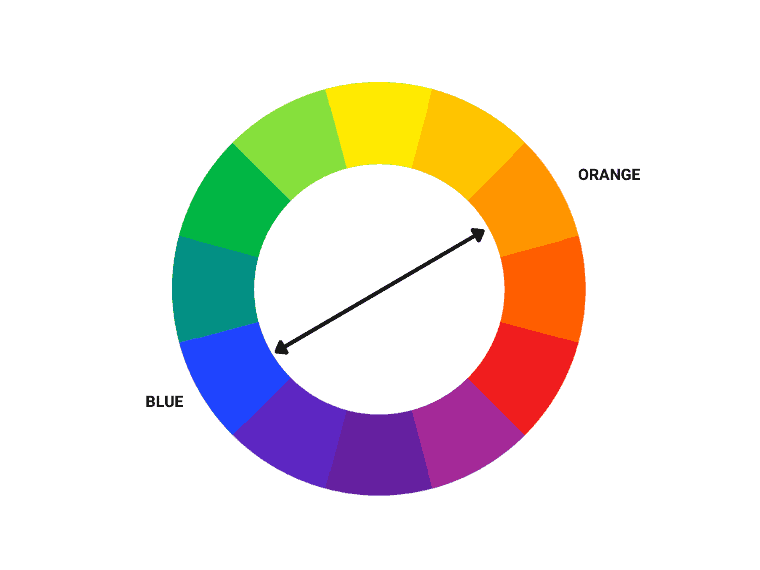
When it comes to traditional art, we discuss the RYB space – the oldest subtractive color model.
Blue, along with red and yellow, is a primary color. Its complementary color, or the color opposite blue on the color wheel, is orange.
Blue
Hex #0000FF
RGB 0, 0, 255
CMYK 100, 100, 0, 0
Orange
Hex #FF8000
RGB 255, 128, 0
CMYK 0, 50, 100, 0
Why orange? Because it’s the color that, when mixed with blue, will give a neutral gray-brown color.
In the RYB wheel, the opposite of blue can’t be yellow. That’s because when these colors are mixed, they produce green and break one of the basic rules of complementary colors. This says that when two opposite colors are mixed, they cancel each other out, losing hue.
Thus, orange is the opposite color of blue in the RYB color wheel. This secondary color is created by mixing the other two primary colors, red and yellow.
Blue-orange is one of the three primary opposites in the RYB color wheel, along with yellow-purple and red-green.
What’s the Opposite of Different Blue Colors?
Even if inverted blue stands for orange or yellow – depending on the color model you work in, there are a variety of shades of blue. However, one thing is true of all variations: any opposite color will have the same degree of saturation and brightness as the main one. For example, the opposite color of light blue will be a pale orange, almost coral.
What Is the Opposite of Azure?
Azure is a tertiary color in RGB and CMYK, an equal mix of cyan and blue. The opposite of azure is orange. This combination provides excellent contrast but also forms a brilliant combo in terms of color meaning.
Orange is associated with enthusiasm, energy, and optimism. Blue stands for relaxation, loyalty, and trust.
Azure
Hex #0080FF
RGB 0, 128, 255
CMYK 100, 50, 0, 0
Bright Orange
Hex #FF8000
RGB 255, 128, 0
CMYK 0, 49.8, 100, 0
What Is the Opposite of Cyan?
Cyan is a greenish-blue created by mixing two colors: green and blue. Cyan is also a primary color in the CMY model and a secondary color in the RGB model.
Red is the opposite of cyan, forming an eye-pleasing combo. It brings to mind sunsets in tropical areas where turquoise water best complements the setting sun.
Red stands for passion, action, and courage. Cyan is associated with relaxation, rationality, and vitality.
Cyan
Hex #00FFFF
RGB 0, 255, 255
CMYK 100, 0, 0, 0
Red
Hex #FF0000
RGB 255, 0, 0
CMYK 0, 100, 100, 0
What Is the Opposite of Royal Blue?
The opposite of royal blue is metallic gold. It is also called super lemon in the Pantone system or New Yellow in RAL.
Royal blue also pairs great with orange – its complementary color on the RYB wheel. Moreover, it also goes beautifully with other shades of yellow-orange, such as apricot (#FFC9B5), maize (#FFF275), citrine (#ECD444), or harvest gold (#ECA400).
Royal Blue
Hex #4169E1
RGB 65, 105, 225
CMYK 71, 53, 0, 12
Gold (Metallic)
Hex #E1B941
RGB 225, 185, 65
CMYK 0, 18, 71, 12
Royal blue pairs are great with orange as well. Moreover, it also goes beautifully with other shades of yellow-orange, such as apricot (#FFC9B5), maize (#FFF275), citrine (#ECD444), or harvest gold (#ECA400).
What Is the Opposite of Light Blue?
Light blue is a pale version of blue associated with tranquility and relaxation. This color was first mentioned in English in 1915.
The opposite of light blue is dusty pink, similar to smoky salmon and peach powder. Its hex code is #E6BBAD.
Light Blue
Hex #ADD8E6
RGB 173, 216, 230
CMYK 25, 6, 0, 10
Dusty Pink
Hex #E6BBAD
RGB 230, 187, 173
CMYK 0, 19, 25, 10
What Is the Opposite of Baby Blue?
Baby blue is a pale blue inspired by the era when newborn males wore blue. Its hex code is #89CFF0.
The opposite color of baby blue is pale coral, light orange with a hint of pink.
Baby Blue
Hex #89CFF0
RGB 137, 207, 240
CMYK 43, 14, 0, 6
Pale Coral
Hex #F0AA89
RGB 240, 170, 137
CMYK 0, 29, 43, 6
What Is the Opposite of Navy Blue?
Navy blue is a very dark blue, named after the uniforms worn by British Royal Navy officers in 1748. Furthermore, this color originates from indigo dye and is often perceived as a color between blue and black.
The opposite of navy blue is olive, also referred to as yellow, with lots of black. Its hex code is #808000. It also goes well with brown chocolate – it’s the complementary color on the RYB color wheel.
Navy Blue
Hex #000080
RGB 0, 0, 128
CMYK 100, 100, 0, 50
Olive Green
Hex #808000
RGB 128, 128, 0
CMYK 0, 0, 100, 50
What Is the Opposite of Dark Blue?
Dark blue is a deep shade of blue associated with wisdom, elegance, authority, trust, and loyalty. Dark blue and navy blue are distinct colors, though they are frequently confused.
But what’s the difference between these colors?
The difference between dark blue and navy blue is that dark blue has a higher brightness, making it appear slightly lighter than navy blue.
Since it resembles navy blue, the opposite color of dark blue is similar. The opposite color of dark blue is olive (in the RGB color wheel) or brown chocolate (in the RYB color wheel).
Let’s see how it looks with brown:
Dark Blue
Hex #00008B
RGB 0, 0, 139
CMYK 100, 100, 0, 45
Brown
Hex #8B4600
RGB 139, 70, 0
CMYK 0, 50, 100, 45
What Is the Opposite of Tiffany Blue?
Tiffany blue is a mixture of bright green and blue, named after Tiffany&Co’s jewelry line. The opposite of Tiffany blue is dark red.
Tiffany Blue
Hex #0ABAB5
RGB 10, 186, 181
CMYK 95, 0, 3, 27
Dark Red
Hex #BA0A10
RGB 186, 10, 16
CMYK 0, 95, 91, 27
Last Words
Still wondering what color is the opposite of blue?
If you look at a traditional color wheel, you might see that orange is the opposite color of blue. This is true, but only in the RYB color space used in traditional art.
From a more scientific perspective, you will see that yellow is the complementary color to blue. This applies to both the subtractive (CMY) and additive (RGB) models.
Also, two different shades of blue have different opposites. Also, two different shades of blue have different opposites. While light blues contrast with pale oranges, dark blues contrast with colors that range from very dark yellows to chocolate brown.
Did you enjoy this article about the opposite color of blue? Help us spread the word by sharing it with your friends who might be interested in learning more about blue’s complementary color.

